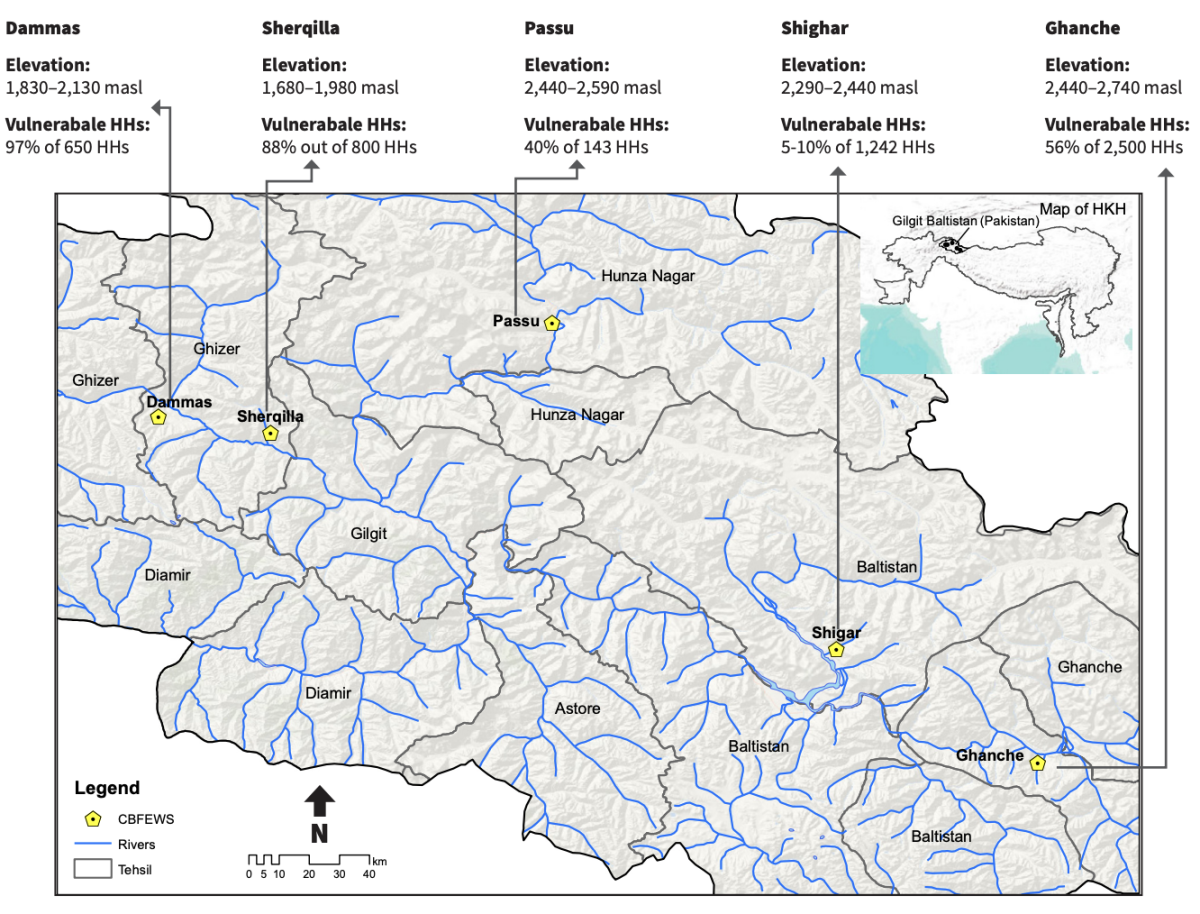Saving lives and property — The fight against yearly flash floods in the Hindu Kush Himalaya: a case study of Pakistan

Summary
In the Hindu Kush Himalaya (HKH) region, there are gaps in relaying early warning information to communities that are most vulnerable which increases potential damage to life and property in case floods or other disasters occur. A properly designed and implemented early warning system can save lives and reduce property loss by increasing the lead time for communities to prepare and respond to floods at the ground level. The Community Based Flood Early Warning System (CBFEWS) is a system designed to disseminate information about incoming floods to vulnerable communities downstream through a network of key stakeholders that can include communities, government bodies, social mobilizers, volunteers, and NGOs.
Floods and flash floods are major natural hazards in the Hindu Kush Himalaya (HKH). They are catastrophic to vulnerable riverside communities, particularly during the monsoon season. Floods can be disastrous even in small rivers and tributaries. The frequency and magnitude of extreme weather events and natural hazards in the region is increasing with climate variability and change.
Pakistan, one of the countries in the HKH, was listed in the “Very High” category in the Climate Risk Index for 1998–2017. It is also one of the five South Asian countries with the highest annual average number of people physically exposed to flood risks. Gilgit–Baltistan is an upstream source of crucial watersheds within Pakistan, including the Indus River basin. The territory also houses some of the most vulnerable mountain communities as far as water-induced hazards are concerned. The risk of such hazards in Gilgit–Baltistan has to do with changing climatic patterns in the form of rising temperatures (which cause glacial melt at a faster pace), heavy snowfall in the winters, and unpredictable precipitation levels during the summers. These have triggered increasing landslides, flash floods, and debris flows, wreaking havoc on both infrastructure and agriculture.
Overview
- Location:
- Implementation sites:
- Multiple countries
- Multiple locations
- Mountain region:
Hindu Kush Himalaya
- Solution scale:
- Ecosystem type(s):
- Solution type(s):
- Sector(s):
- Climate impact(s) addressed:
- Impact time-scales:
- Co-benefits:
- Implementation timeline:
- 2010 - 2020
Solution details
Main beneficiaries & outcomes
The CBFEWS technology has helped save many lives and prevented the loss of property for the most vulnerable since it was first deployed in 2010.
In the case of Pakistan’s pilot projects, most people in the vulnerable villages now believe that the flood early warning system has reduced psychological stress. They also mention that the system has helped them to plan better in terms of and managing flood risks. In addition, a series of regional hands-on training programmes on the installation and use of flood-monitoring devices organized by ICIMOD for caretakers, vulnerable communities, and representatives from local governments and NGOs, have been helpful in enhancing their technical expertise as well as conceptual knowledge about the CBFEWS. This has also enabled partners like the Aga Khan Agency for Habitat (AKAH) and WWF-Pakistan to further improve upon the technology through their independent efforts.
Planning and implementation
The Community Based Flood Early Warning System (CBFEWS) was first implemented in 2010 in pilot projects along the Jiadhal and Singora rivers. The piloted system was based on a simple, open-wire-based immersion instrument to detect water level and generate warnings for dissemination downstream. Newer versions of the system have now been deployed in different countries (Afghanistan, India, Nepal, and Pakistan) in the HKH region enabling a transboundary early warning system.
CBFEWS is based on simple and low-cost technology to allow sustainable operation by vulnerable communities. It provides near real-time early warnings when rising flood waters are detected. The warning information is transmitted to caretakers who disseminate the information to the rest of the community, government line agencies, and stakeholders. Although the detection of flood risk and its communication to vulnerable communities are driven by technology, the primary functioning of the CBFEWS lies in a people-centred approach to flood response. Here is how it works:
- Source of early warning – early warning information comes from individuals or organizations that generate a risk message and send it to the concerned authorities and vulnerable communities. The caretaker is the main source of information.
- Recipients of early warning – warning recipients are nodal persons downstream who are part of the communication network. These nodal persons receive the warning message from different channels (e.g. directly from the source, such as a caretaker or other concerned authorities) and instantly communicate it to at-risk households.
- Early warning message – the warning message from the source to the intended recipients could be textual (SMS), verbal/audio (siren, telephone, megaphone), or visual (flag, sign). Warning messages should be concise, understandable, consistent, and tailored to the specific needs of the intended recipients.
- Communication channel – a communication channel is a network of people created for information dissemination. An efficient and reliable communication network is important for CBFEWS to function properly.
This system enables flood vulnerable individuals, communities, and organizations to prepare and take action to reduce loss of lives and property.
Implementation in Pakistan:
Starting as a reconnaissance survey in 2014, the primary objective of the CBFEWS pilots was to not only assess the areas where the systems would be established but also to decide on the suitable equipment for each of the selected sites. In all, five pilot sites – Sherqilla, Damas, Passu, Shigar, and Khaplu – were chosen based on a combination of factors pertaining to the vulnerability of communities and the feasibility of installations of the wireless systems.
The risk assessment for the CBFEWS sites was carried out using a combination of household data collection and analysis of the types of hazards a community would be vulnerable to. In addition, other factors like the severity and duration of hazards were assessed to provide a complete picture of the likely factors that would affect communities in case of a disaster. Moreover, safe evacuation zones were also scoped out for the communities.

Finance
N/A
Innovation
In order to manage any flood-related hazard, it is imperative to strengthen the channels of early warning and data sharing among all the actors concerned. This is especially true in the case of a place like Gilgit– Baltistan, with its scattered population and remote areas; in such a context, there’s also a likelihood of multiple stakeholders coming up with multiple solutions; this is bound to reduce the effectiveness of disaster response. Therefore, bringing innovation to such measures requires collaborative action among the different agencies that are currently operating in the area. In this regard, harnessing the role of local agencies like the GBDMA is important in ensuring a smooth transition between the project implementers and local stakeholders, as well as for further scaling.
Long term project sustainability and maintenance
The CBFEWS has been piloted in an economical mode considering the local socio-economic conditions and the limited budgetary allocation for disaster risk reduction under the annual development plans. Taking these factors into account will likely increase its long-term sustainability.
Furthermore, in July 2019, following discussions in January of the same year, the CBFEWS was handed over to the Gilgit–Baltistan Disaster Management Authority (GBDMA) in Pakistan via an agreement signed between the government and other institutions to secure government ownership. Based on the recommendations gathered from the pilot experience, it was also suggested that the CBFEWS be adapted into local disaster management plans. Considering that the current disaster management plan of Gilgit–Baltistan is largely focused on disaster response, learnings from the CBFEWS pilot interventions would be instrumental in drawing attention to disaster preparedness and adaptation with the help of innovative solutions in the context of a changing climate scenario.
Capacities for design and implementation
Knowledge
Community champions act as caretakers, who are trained to interpret and relay the information generated by the early warning system to the downstream communities through pre-established channels. This allows flood-vulnerable individuals, communities, and organizations to prepare and take action to reduce the risk of damage or loss of lives and property. To enhance the capacity of the local communities and relevant institutions, ICIMOD has conducted hands-on training and annual refreshers.
Institutional
The CBFEWS, although implemented by ICIMOD, are managed by communities. The experience from ICIMOD’s pilot sites in Pakistan have shown how sustained partnerships among the vulnerable communities in the flood-prone areas of the Upper Indus basin played a key role in providing real-time early warning information and thereby saved lives.
Furthermore, involving agencies like the Gilgit–Baltistan Disaster Management Authority (GBDMA) from the very beginning of the planning and implementation processes of the CBFEWS helped in improving coordination, enhancing institutional capacity, building trust, and finally in handing over its ownership to the local agencies. This also paved way for identifying the elements that are required for its sustainability and upscaling.
Working with the private sector has helped in technology transfer at the local level and in the outscaling of the CBFEWS via locally manufactured instruments Utilizing the resources of local industries is important for two reasons. First, it promotes buy-in from local partners and stakeholders, including private entities, regarding the fabrication and upkeep of the CBFEWS components. Secondly, given the sensitivity of the region, things become easier if the systems fabricated by local manufacturers are used. In Pakistan, local engineering agencies have been working with national and local institutions in preparing instrumentations for institutions like the Pakistan Meteorological Department (PMD), the Water and Power Development Authority (WAPDA), and the Space and Upper Atmosphere Research Commission (SUPARCO). During the CBFEWS project’s runtime, a local manufacturing agency, Burraq Integrated Solutions (BIS), was also able to manufacture a fully indigenized flood early warning system, which is not only economical but also readily available for further scaling up.
Socio-cultural
The local communities are the ultimate custodians of the early warning systems. Their involvement from its inception to demonstration is crucial. This also enhances their capacity and helps in identifying the necessary factors for the sustainability of the systems. In this regard, ICIMOD’s approach involves the inclusion of local communities in risk scoping, installation, and the operationalization of the early warning system, and in information generation and dissemination. That is why this approach is called the “Community Based Flood Early Warning System”. By increasing community awareness of mitigation and response measures, an early warning system becomes more effective.
Outlook & Scalability
Barriers and adverse effects
The community early warning systems have proven to be less effective when there is inadequate monitoring of the technology and lax caretaking of the site. Furthermore, a limited collaboration between the caretaker and the community became a hindrance in efficiently using the system.
To maximise the benefits of the warning systems and to ensure a more coordinated response, active participation of community volunteers in safeguarding the technology and having stronger collaborative networks with the implementing organization are required.
Potential for upscaling and replication
The system still needs to be further customized at the local level and outscaled to many more flood-vulnerable rivers and tributaries. ICIMOD’s work with communities has focused on ensuring continued operation, system maintenance, and community buy-in. Ensuring long-term operation requires financial sustainability, annual maintenance, compensation for caretakers, regular stakeholder meetings, and strong upstream– downstream collaboration.
Promoting ownership of the system among nodal agencies could enhance sustainability and facilitate the system’s full ownership by communities. For this, CBFEWS needs to be included in annual disaster management strategies and upscaled in all flood prone areas. A network of these instruments would further improve the flood preparedness of communities. The private sector can also contribute to enhancing the technology and improving the instrument’s accessibility.
- Community-Based Flood and Glacial Lake Outburst Risk Reduction in Nepal
- Reducing Risks and Vulnerabilities from Glacial Lake Outburst Floods in Northern Pakistan
- Strengthening Critical Infrastructure Against Natural Hazards Project: Tajikistan
- Reducing climate change induced risks and vulnerabilities from Glacial Lake Outburst Floods





(0) Comments
There is no contentYou must be logged in to reply.